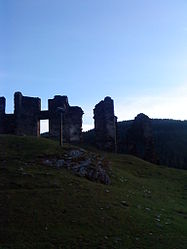world.wikisort.org - France
Saint-Julien-d'Arpaon (Occitan: Sent Julian d'Arpaon) is a former commune in the Lozère department in southern France.[2] On 1 January 2016, it was merged into the new commune of Cans-et-Cévennes.[3] Its population was 93 in 2019.[1]
Saint-Julien-d'Arpaon | |
|---|---|
Part of Cans-et-Cévennes | |
 The ruins of the château in Saint-Julien-d'Arpaon | |
Location of Saint-Julien-d'Arpaon  | |
 Saint-Julien-d'Arpaon  Saint-Julien-d'Arpaon | |
| Coordinates: 44°18′01″N 3°39′59″E | |
| Country | France |
| Region | Occitania |
| Department | Lozère |
| Arrondissement | Florac |
| Canton | Le Collet-de-Dèze |
| Commune | Cans-et-Cévennes |
| Area 1 | 20.72 km2 (8.00 sq mi) |
| Population (2019)[1] | 93 |
| • Density | 4.5/km2 (12/sq mi) |
| Time zone | UTC+01:00 (CET) |
| • Summer (DST) | UTC+02:00 (CEST) |
| Postal code | 48400 |
| Elevation | 580–1,421 m (1,903–4,662 ft) (avg. 610 m or 2,000 ft) |
| 1 French Land Register data, which excludes lakes, ponds, glaciers > 1 km2 (0.386 sq mi or 247 acres) and river estuaries. | |
Saint-Julien-d'Arpaon stands at a crossing of the river Mimente on the Robert Louis Stevenson Trail (GR 70), a popular long-distance path following approximately the route travelled by Robert Louis Stevenson in 1878 and described in his book Travels with a Donkey in the Cévennes.[4] Stevenson mentions the village and its ruined chateau in passing, though not by name:
...the road passed hard by two black hamlets, one with an old castle atop to please the heart of the tourist.[5]
See also
References
- Téléchargement du fichier d'ensemble des populations légales en 2019, INSEE
- Des villages de Cassini aux communes d'aujourd'hui: Commune data sheet Saint-Julien-d'Arpaon, EHESS. (in French)
- Arrêté préfectoral 2–14 December 2015
- Castle, Alan (2007). The Robert Louis Stevenson Trail (2nd ed.). Cicerone. pp. 129–127. ISBN 978-1-85284-511-7.
- Stevenson, Robert Louis (1905) [1879]. . Travels with a Donkey in the Cevennes. New York: Charles Scribner's Sons. p. – via Wikisource.
Wikimedia Commons has media related to Saint-Julien-d'Arpaon.
Текст в блоке "Читать" взят с сайта "Википедия" и доступен по лицензии Creative Commons Attribution-ShareAlike; в отдельных случаях могут действовать дополнительные условия.
Другой контент может иметь иную лицензию. Перед использованием материалов сайта WikiSort.org внимательно изучите правила лицензирования конкретных элементов наполнения сайта.
Другой контент может иметь иную лицензию. Перед использованием материалов сайта WikiSort.org внимательно изучите правила лицензирования конкретных элементов наполнения сайта.
2019-2025
WikiSort.org - проект по пересортировке и дополнению контента Википедии
WikiSort.org - проект по пересортировке и дополнению контента Википедии